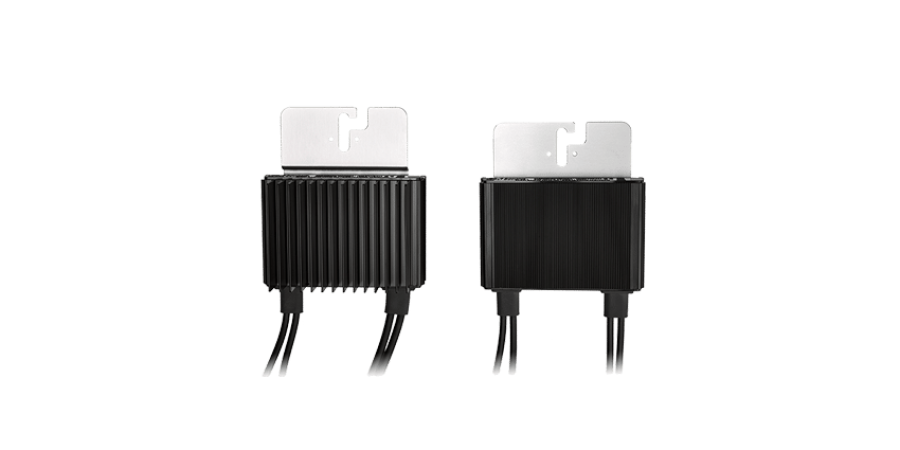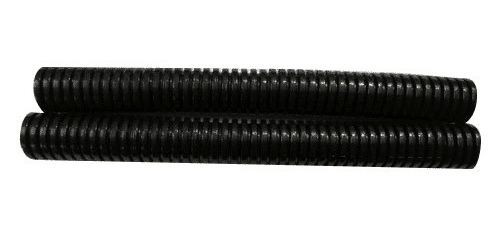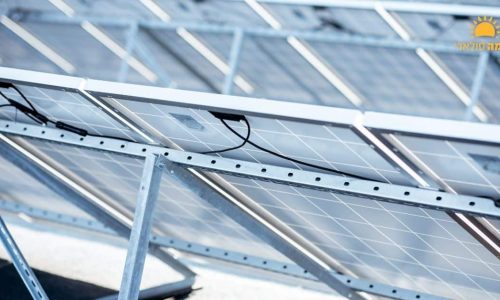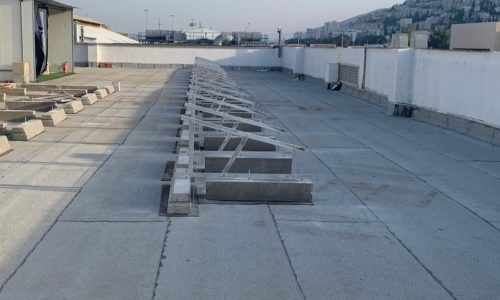Optimizer
We recommend that any residential solar array and most commercial arrays employ SolarEdge inverters and their patented “optimizers.” Optimizers allow you to separate the production of each panel (or pair of panels in commercial systems) so that shading or maintenance issues on one panel won’t affect the rest of the panels in the system.
From SolarEdges website:
What are Power Optimizers and how do they work?
SolarEdge Power Optimizers are DC/DC converters connected by installers to each solar module, effectively turning them into smart modules. They were developed by SolarEdge’s founders in order to solve the problem of module mismatch in PV systems. The five founders envisioned a device that could be attached to each solar module and, using Maximum Power Point Tracking algorithms, maximize the amount of power each module produces individually.
Pictured: SolarEdge Power Optimizers being installed on a cowshed rooftop
Also, in traditional string inverters without Power Optimizers, the power production of all modules is determined by the weakest performing solar module in that string. So, when one of your modules gets damaged or dirty, either the performance of all the modules drops, or the lower-performing modules may stop producing all together until the issue is resolved.
However, SolarEdge’s DC optimized inverter and Power Optimizer combination is different. Through the deployment of Power Optimizers, our commercial PV solution moves the management to the module instead of the string or inverter. SolarEdge Power Optimizers use Maximum Power Point Tracking technology (MPPT) to manage the power of each individual module so that each reaches its own maximum potential, regardless of the performance of the other modules.
Since Power Optimizers enable each module to operate individually, SolarEdge’s commercial PV solutions offer more design flexibility in the system layout, making it possible for more locations to have a PV system. For example, modules can be installed vertically, horizontally, and on different facets of the roof. This also allows for more modules to be included in your PV system, meaning more energy is produced at a lower cost per watts in the long run.
Pictured: SolarEdge commercial PV installations illustrating different string lengths, azimuths, and orientations.
Multi-layer Safety Begins at the Module Level
Through Power Optimizers connected to each module, we have developed state-of-the-art PV safety technology. Our commercial safety feature suite is one of the most important reasons why PV installers around the world choose SolarEdge. While PV systems are generally safe, certain safety measures must be considered during installation and maintenance. However, not all safety technology is created equal.
Traditional inverters have limited safety functionality. This is because as long as the sun is up, current is flowing through the DC cables, even when the inverter is shutdown. Therefore, in the event of a hazard, the roof is still unsafe for first responders.
Our suite of multilayer safety features is designed to keep your system safe during installation, maintenance, and emergencies, even when the sun is shining. And through our Power Optimizers, we can make implementation of the new IEC safety regulations more cost-effective.
All SolarEdge systems have a built-in SafeDCTM safety feature that automatically reduces the DC voltage to touch-safe levels and complies with some of the world’s highest safety standards, including the U.S. NEC 2017 rapid shutdown requirements, new IEC safety standards, and many more.
Other embedded safety suite features include arc fault detection and prevention to detect and mitigate the effects of electrical arcs, and built-in temperature monitoring to proactively monitor and detect faulty wiring at the module level.
These types of safety innovations offer benefits to all stakeholders. Firefighters can approach the roof without risk of electrocution. Maintenance personnel can perform physical inspections on the PV system.
The SolarEdge Monitoring Platform: Pinpoint Visibility Down to the Module Level
SolarEdge’s Monitoring Platform utilizes our Power Optimizers to offer complete data on any PV system down to the module, string, inverter, or system level. This enables immediate fault detection, real-time alerts, and comprehensive analysis that can ultimately reduce Operation and Maintenace (O&M) costs by making it possible to identify and resolve problems remotely. For system investors and managers, this means less time spent onsite for your service teams along with more system uptime. This is something that was not previously possible with traditional inverters. If one of your modules was not working properly, you had no way of knowing there was an issue.
Pictured: SolarEdge’s Monitoring Platform with module-level view for installers and O&M providers
The DC cables
After connection the solar panels to optimizers the team needs to connect a set of panels and optimizers into a “string” that together are combined into one main DC cable that leads to the inverter. Depending on system size residential projects have one or two strings. Commercial systems can have many, many more depending on the system size. The DC cables are connected with a positive red end and negative black end creating a full circuit. Before being connected directly to the inverter, the cables are connect to a DC junction box for safety purposes and one main cable is connected to the inverter for each string.
Grounding
The entirety of the solar array is grounded for safety purposes. Each panel is grounded to the racking system with special “spiked” fasteners that ensure a continuous connection for 25+ years. The racking system is grounding with copper grounding cable between each section, which then connects to a main grounding cable, which heads down to the grounding junction box, inverter, and main grounding of the building. All conduits are also grounded, just in case.
If a building is not properly grounded to begin with, our team will add a “grounding pool” made of copper nodes driven into the earth and connected to the building’s main grounding bar with a thick 35mm copper cable.
Summary
Your installer must do high-quality electrical work on your roof. Any mistakes can short your PV system or lead to dangerous safety lapses. Our teams are trained to install correctly and in a way that will keep the system functioning for its entire lifetime. Of course, every installation element is inspected by a licensed independent inspector to ensure that all is working and up to code. The materials, techniques, and inspections can be the difference between printing money on your roof and dealing with a constant headache of problems and issues.
Interested in installing a solar system on your roof? Contact us today!





